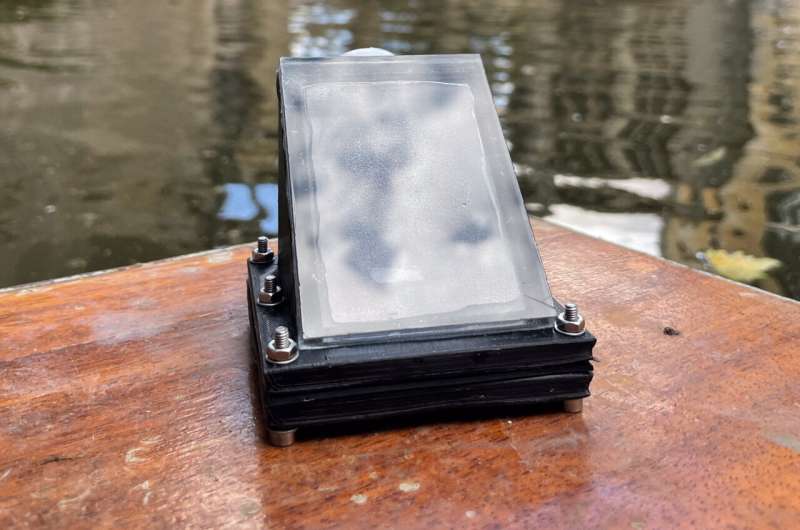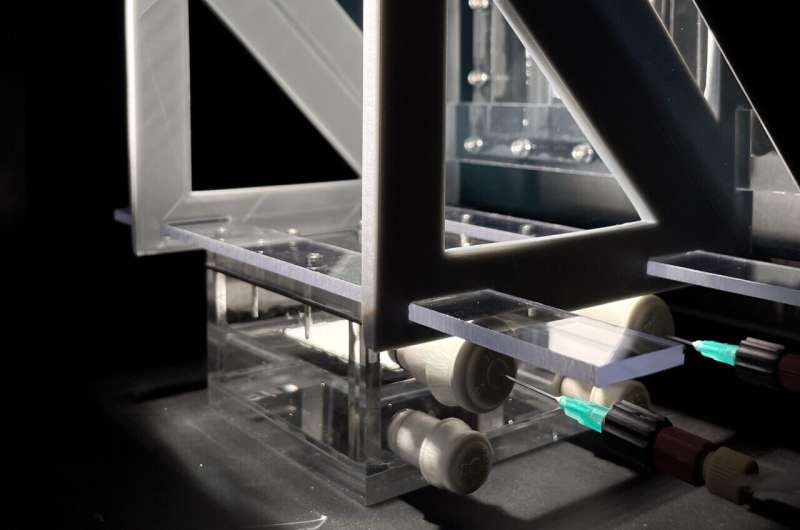This article has been reviewed according to Science X's editorial process and policies. Editors have highlighted the following attributes while ensuring the content's credibility:
fact-checked
peer-reviewed publication
trusted source
proofread
Solar-powered device produces clean water and clean fuel at the same time

A floating, solar-powered device that can turn contaminated water or seawater into clean hydrogen fuel and purified water, anywhere in the world, has been developed by researchers.
The device, developed by researchers at the University of Cambridge, could be useful in resource-limited or off-grid environments, since it works with any open water source and does not require any outside power.
It takes its inspiration from photosynthesis, the process by which plants convert sunlight into food. However, unlike earlier versions of the "artificial leaf," which could produce green hydrogen fuel from clean water sources, this new device operates from polluted or seawater sources and can produce clean drinking water at the same time.
Tests of the device showed it was able to produce clean water from highly polluted water, seawater, and even from the River Cam in central Cambridge. The results are reported in the journal Nature Water.
"Bringing together solar fuels production and water purification in a single device is tricky," said Dr. Chanon Pornrungroj from Cambridge's Yusuf Hamied Department of Chemistry, the paper's co-lead author. "Solar-driven water splitting, where water molecules are broken down into hydrogen and oxygen, need to start with totally pure water because any contaminants can poison the catalyst or cause unwanted chemical side-reactions."

"In remote or developing regions, where clean water is relatively scarce and the infrastructure necessary for water purification is not readily available, water splitting is extremely difficult," said co-lead author Ariffin Mohamad Annuar. "A device that could work using contaminated water could solve two problems at once: it could split water to make clean fuel, and it could make clean drinking water."
Pornrungroj and Mohamad Annuar, who are both members of Professor Erwin Reisner's research group, came up with a design that did just that. They deposited a photocatalyst on a nanostructured carbon mesh that is a good absorber of both light and heat, generating the water vapor used by the photocatalyst to create hydrogen. The porous carbon mesh, treated to repel water, served both to help the photocatalyst float and to keep it away from the water below, so that contaminants do not interfere with its functionality.
In addition, the new device uses more of the sun's energy. "The light-driven process for making solar fuels only uses a small portion of the solar spectrum—there's a whole lot of the spectrum that goes unused," said Mohamad Annuar.
The team used a white, UV-absorbing layer on top of the floating device for hydrogen production via water splitting. The rest of the light in the solar spectrum is transmitted to the bottom of the device, which vaporizes the water.
"This way, we're making better use of the light—we get the vapor for hydrogen production, and the rest is water vapor," said Pornrungroj. "This way, we're truly mimicking a real leaf, since we've now been able to incorporate the process of transpiration."

A device that can make clean fuel and clean water at once using solar power alone could help address the energy and the water crises facing so many parts of the world. For example, the indoor air pollution caused by cooking with "dirty" fuels, such as kerosene, is responsible for more than three million deaths annually, according to the World Health Organization. Cooking with green hydrogen instead could help reduce that number significantly. And 1.8 billion people worldwide still lack safe drinking water at home.
"It's such a simple design as well: in just a few steps, we can build a device that works well on water from a wide variety of sources," said Mohamad Annuar.
"It's so tolerant of pollutants, and the floating design allows the substrate to work in very cloudy or muddy water," said Pornrungroj. "It's a highly versatile system."
"Our device is still a proof of principle, but these are the sorts of solutions we will need if we're going to develop a truly circular economy and sustainable future," said Reisner, who led the research. "The climate crisis and issues around pollution and health are closely related, and developing an approach that could help address both would be a game-changer for so many people."
More information: Dr. Chanon Pornrungroj et al, Hybrid photothermal-photocatalyst sheets for solar-driven overall water splitting coupled to water purification, Nature Water (2023). DOI: 10.1038/s44221-023-00139-9. www.nature.com/articles/s44221-023-00139-9


















